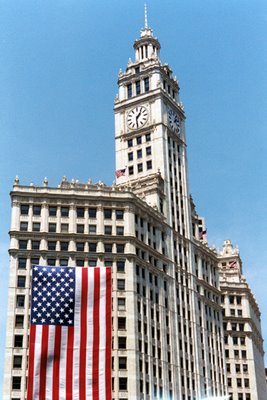
A daily blog on architecture in Chicago, and other topics cultural, political and mineral.
Click on the COMMENTS link under each post to join the discussion.
Friday, June 30, 2006
Wednesday, June 28, 2006
Tuesday, June 27, 2006
Steven Brubaker's University Center of Lake County
 Word from architect Steven Brubaker that he is now in private practice after a long association with HOK, Inc. ,which was in the news last year for their design of the the new Wrigley Global Innovation Center along the Chicago River on Goose Island.
Word from architect Steven Brubaker that he is now in private practice after a long association with HOK, Inc. ,which was in the news last year for their design of the the new Wrigley Global Innovation Center along the Chicago River on Goose Island.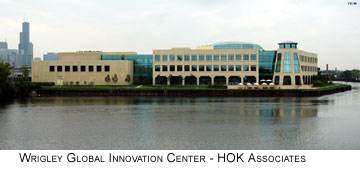
Brubaker's and HOK's University Center of Lake County in Grayslake this part March received the Thomas H. Madigan Award for Outstanding New Construction in Illinois from the Illinois Capital Development Board. The 90,000-square-foot facility, which serves as a Distance Learning Center for a consortium of 17 educational institutions, sited on a prairie, features two brick and concrete blocks, one housing a conference center, the other, classrooms, at either end of a winding steel and glass courtyard. According to Brubaker, the brick facings insulate against northern winds, while the central commons "opens south to the sun."
Among Brubaker's other projects is a new Technology Building for the College of Lake County, recently completed, with a satellite classroom building currently under construction. Brubaker has also recently been selected to design two new buildings for Moraine Valley College, and is teaching a second-year Master's studio at IIT.


Monday, June 26, 2006
Office in a Bucket - (Wasn't That a Song by Sting?)
 Courtesy of the Liquid Treat newsletter, here's news of the latest innovation from London's Inflate, a company dedicated to creating "inflatable structures of all scales". Office in a Bucket is just what the name implies - an inflatable nylon office, conference room or "chill out area" that comes in its own portable bucket. (Batteries not included.) Simply plug it in and watch it expand like some maniacally fast-rising dough. As if life in a cubicle wasn't tenuous enough, now your boss can literally take the wind out of your idea by simply disconnecting a power cord. Oh, and it's perfect for free range chickens, as well. Not to be outdone, The Pleasure Chest is reportedly commissioning Specialty Retailer in a Plain Paper Sack.
Courtesy of the Liquid Treat newsletter, here's news of the latest innovation from London's Inflate, a company dedicated to creating "inflatable structures of all scales". Office in a Bucket is just what the name implies - an inflatable nylon office, conference room or "chill out area" that comes in its own portable bucket. (Batteries not included.) Simply plug it in and watch it expand like some maniacally fast-rising dough. As if life in a cubicle wasn't tenuous enough, now your boss can literally take the wind out of your idea by simply disconnecting a power cord. Oh, and it's perfect for free range chickens, as well. Not to be outdone, The Pleasure Chest is reportedly commissioning Specialty Retailer in a Plain Paper Sack.
Saturday, June 24, 2006
Two great stories make TIF's and patents the stuff of high drama
As I write this early Satursday aftertoon, the sun is shining, so get out and enjoy. Weather forecasters, however, are predicting it will grow dark and rainy, and if you're forced indoors, it's as good a time as ever to take on some great reading on a couple of disturbing topics.
The TIF Scam - The Chicago Reader's Ben Joravsky has another great article on how the Chicago's burgeoning tax increment financing districts are turning into a vast, corrupt quagmire that put the patronage hiring scandals currently hogging the front pages to shame. Originally designed to subsidize the revitalization of depressed areas, TIF's have become a giant - and legal - patronage system with billions of dollars at its disposal. Just last week, the Daley administration PR machine was greasing the skids for a renewal of the Central Loop TIF, currently siphoning off about $90,000,000 in property taxes a year, by announcing TIF's would help fund a billion dollar plan to construct 24 new Chicago schools.
As Joravsky explains, not only is this spending on tax-exempt properties a complete corruption of TIF's original purpose to encourage private development and expand the tax base, it is also a cynical shell game that still leaves the city's schools with hundreds of millions of dollars less than they would have received if the TIF's were abolished.
But wait, there's more!
Joravsky exposes how the corruption has now also captured state finances. Accordingly to Joravsky, the TIF's have lowered the city's tax commitment to schools below a mandated state threshhold, which the State of Illinois then makes up for, by Joravsky's estimate, to the tune of $112,000,000 in 2004.
So let's summarize:
1. TIF's, created to subsidize private development to expand the tax base, are now funding public development that pay no taxes.
2. TIF's, meant to be a temporary solution, are so addictive to politicians that not one is currently scheduled to be phased out.
3. Taxpayers get to pay for the TIF's twice, once through their property taxes, and then again through their state income taxes when the state steps in to reimburse city schools for property tax revenues lost through the TIF's.
4. Because of this shell game, politicians continue to cynically claim that they haven't raised taxes.
The New Ideas Trust - The current Business Week's cover story is an eye-opening look at the Intellectual Property empire currently being built by Microsoft's former head tech guru Nathan Myhrvold. It starts out bright and shiny and positive as it describes a brainstorming session where Myhrvold has brought together some of the most brilliant minds in the country to come up with ideas on how surgery can be improved. Then the camera pulls backs, and we see that everything they say is being monitored by a bank of patent lawyers, who snatch the ideas like so many soap bubbles in the air to transform them into patents that will be owned by Myhrvold's company, Intellectual Ventures. According to Business Week, Myhrvold has a billion dollar war chest with which he's already bought up thousands of patents.
This makes Myhrvoid the world's biggest patent troll. A patent troll is a company that holds or buys up patents which it has no intention of using - Myhrvoid proudly tells Business Week his company manufactures nothing - but uses the dormant patents to shake down companies, who may well have also come up with the same idea on their own, and who actually DO want to manufacture the products or create the services that are improved by the ideas in the patent. Think of SCO's spectacularly unsuccessful, but still damaging, effort to shut down Linux with patent troll litigation. Think also of the U.S.'s amazingly broken patent system, which hands out patents promiscuously for obvious business processes such as Amazon's patent for one-click shopping, where your credit number is remembered so you don't have to reinput it on subsequent visits.
Can a big lobbying push to extend the lives of patents be far behind? Big media companies have already eviscerated copyright law. Originally, copyright law was to make sure authors were compensated for their work. Authors, of course, have a mortal life; corporations, defined as "persons" under the law, do not. Even when corporations die, their assets merely get subsumed by another, succeeding corporation. Barring a complete collapse of society, corporate personhood is immortal. What our Founding Fathers defined as a "reasonable period" for copyright has been turned into perpetual ownership by a Congress hijacked by industry lobbyists. Under the current law's provisions, not a single work created after 1923 will enter the public domain until 2019, if then.
"Not invented here" used to be a slam at inept businessmen who couldn't recognize any good idea unless it came from within. "Only invented here" is the dark promise of Myhrvoid's brave new world - a single company that monopolizes invention, converting every possible idea into a patent that they have the exclusive rights to, which they then sit on until they can sue some company who actually has made a commitment to make the innovation real (Myhrvoid denies this is his intent, but 30% of his employees are patent lawyers), or, as is actually happening, he shakes down corporations for $50,000,000 (for now) "contributions" to be assured they won't be sued by his company. Can anyone believe that such an "Ideas Trust" will do anything other than constrict, perhaps fatally, America's capacity to innovate and compete?
To bring a famous quote from Al Capone up to date, "When I separate a guy from his money with a baseball bat, it's called extortion. When a lawyer does it, it's called Intellectual Property."
The TIF Scam - The Chicago Reader's Ben Joravsky has another great article on how the Chicago's burgeoning tax increment financing districts are turning into a vast, corrupt quagmire that put the patronage hiring scandals currently hogging the front pages to shame. Originally designed to subsidize the revitalization of depressed areas, TIF's have become a giant - and legal - patronage system with billions of dollars at its disposal. Just last week, the Daley administration PR machine was greasing the skids for a renewal of the Central Loop TIF, currently siphoning off about $90,000,000 in property taxes a year, by announcing TIF's would help fund a billion dollar plan to construct 24 new Chicago schools.
As Joravsky explains, not only is this spending on tax-exempt properties a complete corruption of TIF's original purpose to encourage private development and expand the tax base, it is also a cynical shell game that still leaves the city's schools with hundreds of millions of dollars less than they would have received if the TIF's were abolished.
But wait, there's more!
Joravsky exposes how the corruption has now also captured state finances. Accordingly to Joravsky, the TIF's have lowered the city's tax commitment to schools below a mandated state threshhold, which the State of Illinois then makes up for, by Joravsky's estimate, to the tune of $112,000,000 in 2004.
So let's summarize:
1. TIF's, created to subsidize private development to expand the tax base, are now funding public development that pay no taxes.
2. TIF's, meant to be a temporary solution, are so addictive to politicians that not one is currently scheduled to be phased out.
3. Taxpayers get to pay for the TIF's twice, once through their property taxes, and then again through their state income taxes when the state steps in to reimburse city schools for property tax revenues lost through the TIF's.
4. Because of this shell game, politicians continue to cynically claim that they haven't raised taxes.
The New Ideas Trust - The current Business Week's cover story is an eye-opening look at the Intellectual Property empire currently being built by Microsoft's former head tech guru Nathan Myhrvold. It starts out bright and shiny and positive as it describes a brainstorming session where Myhrvold has brought together some of the most brilliant minds in the country to come up with ideas on how surgery can be improved. Then the camera pulls backs, and we see that everything they say is being monitored by a bank of patent lawyers, who snatch the ideas like so many soap bubbles in the air to transform them into patents that will be owned by Myhrvold's company, Intellectual Ventures. According to Business Week, Myhrvold has a billion dollar war chest with which he's already bought up thousands of patents.
This makes Myhrvoid the world's biggest patent troll. A patent troll is a company that holds or buys up patents which it has no intention of using - Myhrvoid proudly tells Business Week his company manufactures nothing - but uses the dormant patents to shake down companies, who may well have also come up with the same idea on their own, and who actually DO want to manufacture the products or create the services that are improved by the ideas in the patent. Think of SCO's spectacularly unsuccessful, but still damaging, effort to shut down Linux with patent troll litigation. Think also of the U.S.'s amazingly broken patent system, which hands out patents promiscuously for obvious business processes such as Amazon's patent for one-click shopping, where your credit number is remembered so you don't have to reinput it on subsequent visits.
Can a big lobbying push to extend the lives of patents be far behind? Big media companies have already eviscerated copyright law. Originally, copyright law was to make sure authors were compensated for their work. Authors, of course, have a mortal life; corporations, defined as "persons" under the law, do not. Even when corporations die, their assets merely get subsumed by another, succeeding corporation. Barring a complete collapse of society, corporate personhood is immortal. What our Founding Fathers defined as a "reasonable period" for copyright has been turned into perpetual ownership by a Congress hijacked by industry lobbyists. Under the current law's provisions, not a single work created after 1923 will enter the public domain until 2019, if then.
"Not invented here" used to be a slam at inept businessmen who couldn't recognize any good idea unless it came from within. "Only invented here" is the dark promise of Myhrvoid's brave new world - a single company that monopolizes invention, converting every possible idea into a patent that they have the exclusive rights to, which they then sit on until they can sue some company who actually has made a commitment to make the innovation real (Myhrvoid denies this is his intent, but 30% of his employees are patent lawyers), or, as is actually happening, he shakes down corporations for $50,000,000 (for now) "contributions" to be assured they won't be sued by his company. Can anyone believe that such an "Ideas Trust" will do anything other than constrict, perhaps fatally, America's capacity to innovate and compete?
To bring a famous quote from Al Capone up to date, "When I separate a guy from his money with a baseball bat, it's called extortion. When a lawyer does it, it's called Intellectual Property."
Friday, June 23, 2006
Archidose's John Hill Joins New Partnership
"Gettin' Hitched" was the title of today's entry on John Hill's essential Archidose blog. The architect is off until July 4th for, I hope, an extended honeymoon. Since the papparazzi have yet to come up with photos of the happy couple, we extend our best wishes with this selection of architectural backdrop wedding pictures, from Rome, the lakefront, Michigan Avenue, and Buckingham Fountain.
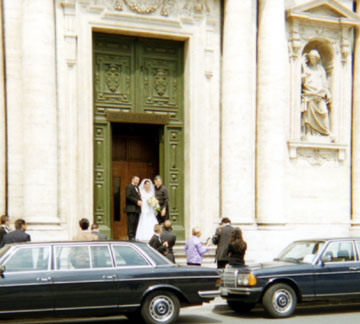







Thursday, June 22, 2006
Out of Time at the Wrigley Building?
 Look, ma, no hands! For the last several weeks, the Wrigley Building's famous clockfaces have been denuded of both big and little, reportedly removed for their own protection during the tower's renovation. We wish them a speedy return, but for now, at least at the foot of the Mag Mile, it's pretty much any time you care to imagine.
Look, ma, no hands! For the last several weeks, the Wrigley Building's famous clockfaces have been denuded of both big and little, reportedly removed for their own protection during the tower's renovation. We wish them a speedy return, but for now, at least at the foot of the Mag Mile, it's pretty much any time you care to imagine.
Wednesday, June 21, 2006
Marquee Value
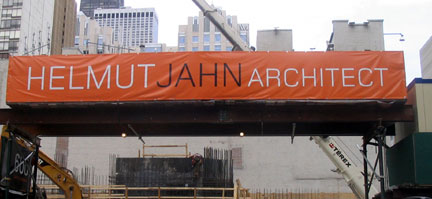 Five years ago, within the Chicago city limits, Helmut Jahn couldn't get a doghouse built. He may have been creating landmark works all across Europe and Asia, but in his home town, he remained a prophet without honor. Then came State Street Village, the stunning dorm complex he designed for the IIT campus, which opened in 2003. Last year, 600 North Fairbanks, his first condo highrise in Chicago was announced, and it's now begun to rise on its Streetville site, just south of the Schatz Building, which in the 1930's through 1960, was home to the fabled Chez Paree night club.
Five years ago, within the Chicago city limits, Helmut Jahn couldn't get a doghouse built. He may have been creating landmark works all across Europe and Asia, but in his home town, he remained a prophet without honor. Then came State Street Village, the stunning dorm complex he designed for the IIT campus, which opened in 2003. Last year, 600 North Fairbanks, his first condo highrise in Chicago was announced, and it's now begun to rise on its Streetville site, just south of the Schatz Building, which in the 1930's through 1960, was home to the fabled Chez Paree night club. For the $100,000,000 600 North Fairbank's developers, Urban R2 Developent and Schatz Development, the architect has come up with a classic Jahn design: a sleek, curtain-walled 41 story, 451-foot-high tower, where the condos are placed over a lobby and 11 floors of parking that progressively cantilever, story-by-story, up to the larger floorplate of the residential portion of the building.
For the $100,000,000 600 North Fairbank's developers, Urban R2 Developent and Schatz Development, the architect has come up with a classic Jahn design: a sleek, curtain-walled 41 story, 451-foot-high tower, where the condos are placed over a lobby and 11 floors of parking that progressively cantilever, story-by-story, up to the larger floorplate of the residential portion of the building.What's also interesting is how prominently Jahn figures in the marketing. The website features several videos of the architect talking about the project, as well as a mini-portfolio of his other buildings. At the construction site, there's another interesting sea change. Usually, on those big billboards listing the credits, the name of the architect is fairly inconspicuous, buried amidst the names of contractor and subcontractors. In contrast, the street signage at 600 North Fairbanks puts the Jahn name front and center. In some ways, it's just a case of Chicago catching up with New York, where the involvement of high profile architects such as Richard Meier has been used to help move units with multi-million dollar price tags. At 600 North Fairbanks, the signage heralds not just Jahn, but what it calls "pure modern vision."

Is cheesy historicism's stranglehold on architectural design in Chicago finally about to be broken?
Monday, June 19, 2006
111 South Wacker Wins Awards from IALD, SEAOI
 111 South Wacker, the new John Buck building designed by Goettsch Partners that, along with Pei Cobb Freed's Hyatt Center just across the street, seems to marking a resurgence in quality skyscraper design in Chicago after a long drought of abominable concrete condo towers, has garnered not one by two recent awards, from both the International Association of Lighting Designers, and the Structural Engineers Association of Illinois. Read all about the engineering challenges 111 South Wacker faced, and see the pictures, here.
111 South Wacker, the new John Buck building designed by Goettsch Partners that, along with Pei Cobb Freed's Hyatt Center just across the street, seems to marking a resurgence in quality skyscraper design in Chicago after a long drought of abominable concrete condo towers, has garnered not one by two recent awards, from both the International Association of Lighting Designers, and the Structural Engineers Association of Illinois. Read all about the engineering challenges 111 South Wacker faced, and see the pictures, here.
Friday, June 16, 2006
Weekend Miscelleany - Fruity Pebbles in the Wine, Il Mare Chicago-Style, and How I Stopped Worrying About Giant Pandas
Why I will never be an wine expert
The new Business Week, which has the misfortune to be running a cover on Bill Gate's philanthropy just days after the even bigger story of his retirement from Microsoft broke, introduces Robert Parker, its new wine columnist (a business magazine without a wine critic is a little more than a rag ), which includes this description of a $150 French Rose:
"Vivid strawberry, raspberry, and berry fruit with hints of smoke, crushed rocks, and a touch of rhubarb." A competing critic was sure she picked up the scent of granite, but Parker is holding firm for an impudent sandstone.
Chicago on Film: The Lake House
Saw the new Sandra Bullock/Keanu Reeves film, The Lake House, which takes the architecture of Chicago as its fundamental mise en scene. The use of dozens of different locations is nothing less than splendid, with even transitional voiceovers placed over handsomely composed shots of some of city's most prominent buildings.
The film's shortfall is not so much the highly intricate plot involving Bullock and Reeves sustaining a relationship even as one of them is living in 2004, the other in 2006. (Did they set their timezone to Bermuda Triangle?) It's that for much of the film's first half, the lead characters seem to be speaking more in plot points than in any kind of recognizably human dialogue, and the action seems more about keeping things moving along than arising out of any organic motivation. As the film progresses beyond the setup, however, you begin to settle into the sometimes overlabored idiom, and the picture begins to gain a real emotional heft. It falls short of being the truly great film it might have become, but it still remains an affectingly poetic meditation on the themes of longing, loneliness and loss. Oh, and Chicago looks great in it.
Endangered Panda Problem Solved!
So you say you're always worrying about the Giant Panda. How anything that huggable could actually be facing extinction? How every time you see one of those adorable, doe-eyed faces, you can think of nothing else but throwing away your boring, empty life just to be able to have one of those cuddly furballs munching bamboo directly from your hand? And what's with the whole breeding thing? The whole world loves them -why can't they love each other, just a bit more often, know what I mean - wink, wink, nudge, nudge? Are these the questions that keep you pacing the floor in the middle of the night, bunky?
with the whole breeding thing? The whole world loves them -why can't they love each other, just a bit more often, know what I mean - wink, wink, nudge, nudge? Are these the questions that keep you pacing the floor in the middle of the night, bunky?
Well, lift up your spirits! Worry no more! Courtesy of Engadget.com we bring you news of the amazing Giant Panda robots, complete with 14 servo motors to create the full range of "realistic panda expressions." You'll be asking yourself: is it Ling-Ling, or Hirsute Mechanicals International? . See the pictures of the pandabots, and if you read Japanese, drop me a note about what they're saying about them.
The new Business Week, which has the misfortune to be running a cover on Bill Gate's philanthropy just days after the even bigger story of his retirement from Microsoft broke, introduces Robert Parker, its new wine columnist (a business magazine without a wine critic is a little more than a rag ), which includes this description of a $150 French Rose:
"Vivid strawberry, raspberry, and berry fruit with hints of smoke, crushed rocks, and a touch of rhubarb." A competing critic was sure she picked up the scent of granite, but Parker is holding firm for an impudent sandstone.
Chicago on Film: The Lake House
Saw the new Sandra Bullock/Keanu Reeves film, The Lake House, which takes the architecture of Chicago as its fundamental mise en scene. The use of dozens of different locations is nothing less than splendid, with even transitional voiceovers placed over handsomely composed shots of some of city's most prominent buildings.
The film's shortfall is not so much the highly intricate plot involving Bullock and Reeves sustaining a relationship even as one of them is living in 2004, the other in 2006. (Did they set their timezone to Bermuda Triangle?) It's that for much of the film's first half, the lead characters seem to be speaking more in plot points than in any kind of recognizably human dialogue, and the action seems more about keeping things moving along than arising out of any organic motivation. As the film progresses beyond the setup, however, you begin to settle into the sometimes overlabored idiom, and the picture begins to gain a real emotional heft. It falls short of being the truly great film it might have become, but it still remains an affectingly poetic meditation on the themes of longing, loneliness and loss. Oh, and Chicago looks great in it.
Endangered Panda Problem Solved!
So you say you're always worrying about the Giant Panda. How anything that huggable could actually be facing extinction? How every time you see one of those adorable, doe-eyed faces, you can think of nothing else but throwing away your boring, empty life just to be able to have one of those cuddly furballs munching bamboo directly from your hand? And what's
 with the whole breeding thing? The whole world loves them -why can't they love each other, just a bit more often, know what I mean - wink, wink, nudge, nudge? Are these the questions that keep you pacing the floor in the middle of the night, bunky?
with the whole breeding thing? The whole world loves them -why can't they love each other, just a bit more often, know what I mean - wink, wink, nudge, nudge? Are these the questions that keep you pacing the floor in the middle of the night, bunky?Well, lift up your spirits! Worry no more! Courtesy of Engadget.com we bring you news of the amazing Giant Panda robots, complete with 14 servo motors to create the full range of "realistic panda expressions." You'll be asking yourself: is it Ling-Ling, or Hirsute Mechanicals International? . See the pictures of the pandabots, and if you read Japanese, drop me a note about what they're saying about them.
Before Sandra and Keanu - Building The Lake House
 Kevin Nance has a nice article in Thursday's Chicago Sun-Times talking about all the Chicago locations used in the new Keanu Reeves/Sandra Bullock romance The Lake House, which was shot here last year and opens nationwide Friday. Written by Chicago native David Auburn, it makes use of an unusually diverse range of Chicago architecture, not just the usual tourist standby's such as the Picasso Statue and the ice rink at Millennium Park, but lesser-known landmarks as the Old Colony and Fine Arts Building. It's reported to be an exceptionally intelligent film - both Keanu Reeves and Christopher Plummer, his father in the movie, play architects. Nance draws an interesting parallel between the picture's time shifting theme and the way architecture, itself, is a kind of time travel that bridges historic eras with the present.
Kevin Nance has a nice article in Thursday's Chicago Sun-Times talking about all the Chicago locations used in the new Keanu Reeves/Sandra Bullock romance The Lake House, which was shot here last year and opens nationwide Friday. Written by Chicago native David Auburn, it makes use of an unusually diverse range of Chicago architecture, not just the usual tourist standby's such as the Picasso Statue and the ice rink at Millennium Park, but lesser-known landmarks as the Old Colony and Fine Arts Building. It's reported to be an exceptionally intelligent film - both Keanu Reeves and Christopher Plummer, his father in the movie, play architects. Nance draws an interesting parallel between the picture's time shifting theme and the way architecture, itself, is a kind of time travel that bridges historic eras with the present.One thing Nance doesn't cover, however, is the film's title star. The Lake House was constructed specifically for the movie at Maple Lake in the Palos Forest Preserve, Production designer Nathan Crowley took the 2,000 square foot structure from sketches to completion in just ten weeks: 2 weeks design and documentation, 4 days bidding, and a scant seven weeks for actual construction. 35 tons of steel were used in the project, and a crew of nearly one hundred was required to finish the house by the time filming was scheduled to begin.
Structural engineers at McDonough Associates were honored for their work on the house by having it nominated as a finalist in the Structural Engineers Association of Illinois 2006 Excellence in Structural Engineering Awards (full disclosure: I served on the jury). The house was actually constructed on dry land next to the lake, atop steel beams that rose 10 feet above the waterline, which was created by excavating nearly 1,200 cubic feet of soil and letting lake waters flood in under the pilings. Although the house would be exposed to strong spring winds, Crowley vetoed diagonal bracing, which would obstruct camera angles. McDonough Associates had to come up with "moment resisting frames" that minimized the kind of lateral movement that could crack the house's all-glass walls.
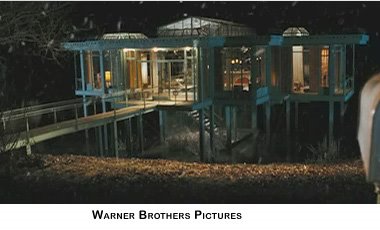 The Lake House, however, is the only one of the movie's Chicago locations that you can't revisit. It was taken down immediately after filming. The soil was put back, and it's now the site of a new fishing pier.
The Lake House, however, is the only one of the movie's Chicago locations that you can't revisit. It was taken down immediately after filming. The soil was put back, and it's now the site of a new fishing pier.
Thursday, June 15, 2006
What Makes Frank Run?

 Sketches of Frank Gehry, a new documentary from veteran director Sydney Pollack, is less a hard-nosed investigation than an engaging and affectionate portrait of a close friend. Pollack, whose work as a director includes Tootsie, Out of Africa, The Firm,and The Way We Were, made the picture over the course of a five-year period that saw Gehry rise from being merely famous to inescapably ubiquitous. Today, Gehry stands alone. Like Frank Lloyd Wright in the 40's and 50's, Frank Gehry, for many, has become the personification of the word, "architect." Read the full review and see the pictures here.
Sketches of Frank Gehry, a new documentary from veteran director Sydney Pollack, is less a hard-nosed investigation than an engaging and affectionate portrait of a close friend. Pollack, whose work as a director includes Tootsie, Out of Africa, The Firm,and The Way We Were, made the picture over the course of a five-year period that saw Gehry rise from being merely famous to inescapably ubiquitous. Today, Gehry stands alone. Like Frank Lloyd Wright in the 40's and 50's, Frank Gehry, for many, has become the personification of the word, "architect." Read the full review and see the pictures here.
Wednesday, June 14, 2006
Jordan Mozer Furniture Designs at Casati Gallery
This past Saturday, Chicago designer Jordan Mozer, whose local work includes everything from Vivere to Cheesecake Factory to Wow Bow in Water Tower Place, opened an exhibition of recent hand-sculpted cast furniture at the Casati Gallery at 949 West Fulton.

 Mozer describes the work as follows:
Mozer describes the work as follows:
"Last year we transformed a mossy and crumbling old iron foundry in Hamburg, Germany into a boutique hotel called East.
The design was inspired by the ghosts of the old iron foundry and an appreciation for the Eastern recognition of a spiritual essence in nature, and also by an urge to create a dreamlike and idiosyncratic personality with both the space and objects within. As always, we created project-specific furnishings from scratch."
(Photos by Doug Snower)

 Mozer describes the work as follows:
Mozer describes the work as follows:"Last year we transformed a mossy and crumbling old iron foundry in Hamburg, Germany into a boutique hotel called East.
The design was inspired by the ghosts of the old iron foundry and an appreciation for the Eastern recognition of a spiritual essence in nature, and also by an urge to create a dreamlike and idiosyncratic personality with both the space and objects within. As always, we created project-specific furnishings from scratch."
(Photos by Doug Snower)
Tuesday, June 13, 2006
Macmansions on Spec?
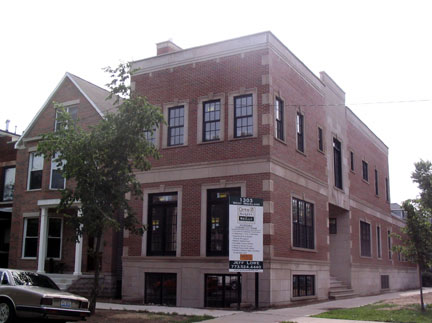 It's no secret that Chicago's condo boom was substantially fueled by speculators buying up units they never intended to live in, but that dynamic now seems to be extending to one-of-kind houses. The graystones and vintage frame homes that have lined the streets west of Wrigley Field for the better part of a century may be no longer immune to the tear-down craze that has so dramatically transformed the fabric of such historic former working class neighborhoods as East Village.
It's no secret that Chicago's condo boom was substantially fueled by speculators buying up units they never intended to live in, but that dynamic now seems to be extending to one-of-kind houses. The graystones and vintage frame homes that have lined the streets west of Wrigley Field for the better part of a century may be no longer immune to the tear-down craze that has so dramatically transformed the fabric of such historic former working class neighborhoods as East Village.
This house on the 1300 block of West Waveland, replacing, if I recall correctly, a somewhat ramshackle wood home, pretty much exemplifies the downside of this trend. Out of scale with its neighbors, its characterless detailing of simplistic limestone corbels, keystones and cornices offers only inadequate relief to a bloated brick-faced massing that seems to suggest the livid skin of a boiled, overfed pig. What makes the story a bit more interesting is that the house was built without a owner -unless they dropped out along the way (and who could blame them?) Which raises mixed feelings. If something this prominent lays empty, it becomes an even worse eyesore, but if its snapped up, will they just make more?

Monday, June 12, 2006
Fewer Spaces in Paradise (unless you're a car)
 The ultra-luxury, 700-foot-tall Elysian, Lucien LaGrange's latest contribution to the Masked Ball school of architecture, seems to be getting rid of the riff-raff. A year ago, the developer was claiming to have signed contracts for 95 of the 183 hotel/condos, intended to be in-town apartments or rented out when the owner was away. The project also included 51 private residences, priced $2,500,000 and up.
The ultra-luxury, 700-foot-tall Elysian, Lucien LaGrange's latest contribution to the Masked Ball school of architecture, seems to be getting rid of the riff-raff. A year ago, the developer was claiming to have signed contracts for 95 of the 183 hotel/condos, intended to be in-town apartments or rented out when the owner was away. The project also included 51 private residences, priced $2,500,000 and up.This Thursday, First Elysian Properties is coming before the Chicago Plan Commission asking approval for decreasing the number of units down to 144, while increasing the building's FAR from 18.73 to 21.68 and upping the number of parking spaces by 50%, to 188. Could this be a sign that the supply of millionaire buyers is finally getting depleted, or has the market proved soft for the hotel suites? I'd like to think it's a reaction against retro design (the Elysian even includes a French-Empire-styled "carriage court") in favor of projects like SOM's Trump Tower and Santiago Calatrava's Fordham Spire, but that's probably too much to ask.
The site has been vacant and inactive since last summer, when the Lo-Cal Zone, the concrete shack, in comparison to its replacement a bastion of architectural integrity, was demolished.
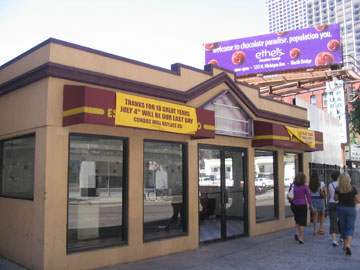
Saturday, June 10, 2006
Douglas Garofalo, H. Allen Brooks and Martha Thorne among late additions to June Calendar
 Four late additions to the June calendar of architectural events includes the opening at the Art Institute of an exhibition of the work of Chicago architect Douglas Garofalo, with a members reception on the 14th and public opening on the 17th. This is the 150 anniversary year of the birth of Louis Sullivan, and the Society of Architectural Historians is marking the event with a lecture, Louis H. Sullivan: Father of the Prairie School, by renowned scholar H. Allen Brooks at the Graham Foundation, 6:00 P.M. on Monday, June 19th. On the afternoon of the 27th at Fullerton Hall in the Art Institute, Martha Thorne, the new executive director of the Pritzker Prize will speak on The Pritzker Architecture Prize: Past and Present. Finally, on Thursday, the 22nd, The Urban Land Institute is putting on a breakfast seminar at the Mid-Day Club on the Revitalization of State Street & East Loop Retail.
Four late additions to the June calendar of architectural events includes the opening at the Art Institute of an exhibition of the work of Chicago architect Douglas Garofalo, with a members reception on the 14th and public opening on the 17th. This is the 150 anniversary year of the birth of Louis Sullivan, and the Society of Architectural Historians is marking the event with a lecture, Louis H. Sullivan: Father of the Prairie School, by renowned scholar H. Allen Brooks at the Graham Foundation, 6:00 P.M. on Monday, June 19th. On the afternoon of the 27th at Fullerton Hall in the Art Institute, Martha Thorne, the new executive director of the Pritzker Prize will speak on The Pritzker Architecture Prize: Past and Present. Finally, on Thursday, the 22nd, The Urban Land Institute is putting on a breakfast seminar at the Mid-Day Club on the Revitalization of State Street & East Loop Retail.Oh, and then, although I've decided there's just too much to list on the Repeat
 calendar, there's that little thing called NEOCON, at the Merchandise Mart from the 12th to the 14th, including keynotes by Ron Arad, Vicente Wolf and Clive Wilkinson, and a number of special events such as a "VIP Reception" for Art Institute curator Joseph Rosa before he speaks on his "New Vision for Architecture & Design".
calendar, there's that little thing called NEOCON, at the Merchandise Mart from the 12th to the 14th, including keynotes by Ron Arad, Vicente Wolf and Clive Wilkinson, and a number of special events such as a "VIP Reception" for Art Institute curator Joseph Rosa before he speaks on his "New Vision for Architecture & Design".
Thursday, June 08, 2006
Mini-Manhattan Rising on Evanston's Fountain Square
 This week's Crain's Chicago Business includes a brief blurb on developer Thomas Rozak's intention to construct a 38 story residential/hotel tower on Evanston's Fountain Square. The Square, consisting of a fountain, some trees, seating, and tall brick columns commemorating the city's war dead, is slowly being overwhelmed by new, high-density projects.
This week's Crain's Chicago Business includes a brief blurb on developer Thomas Rozak's intention to construct a 38 story residential/hotel tower on Evanston's Fountain Square. The Square, consisting of a fountain, some trees, seating, and tall brick columns commemorating the city's war dead, is slowly being overwhelmed by new, high-density projects.On one corner is Schipporeit-Heinrich Associates's 1969 Chase Building (originally First National Bank) 22 stories, and 277 feet high, and, according to Emporis, the first skyscaper in Evanston. Lead designer George Shipporeit, who also designed Lake Point Tower, created a tall classically Miesian shaft set off by a one-story, circular, glass-walled banking rotunda to the south. To its west is Daniel Coffey's Sherman Plaza, 25 stories, 276 feet, and currently nearing completion. In between is the classically simple, 5 story International-style Fountain Square building, a short stack between two tall bookends, set to be demolished for the Rozak project, which will soar above its two neighbors.

Evanston continues to be in the grip of a building boom. On still another Fountain Square corner is David Hovey's 2002 Optima Towers, 13 stories, 136 feet, with the the orange balconies that have become a Hovey trademark.
Chase Plaza includes a generous amount of open space and landscaping, but the newer structures tend to hog the lot lines. Fountain Square itself is set, not centrally, but off the northern edge of the intersection, and what should be a strong urban plaza is increasingly a limp, unfocused appendange to the buildings around it.
POSTSCRIPT:
One of our readers submitted the following images for the project - a site plan, and a rendering. The tower is actually set off away from Fountain Square, to the north end of the site. Facing Fountain Square, itself, is a two-story retail structure which is so bland and generic that you can't help but wonder why they don't just incorporate the rather handsome international-style building already on that corner.


Wednesday, June 07, 2006
A Lost World - a vanished era finds it voice in the ruins of a movie palace

The era of the movie palace is one of the most incredible - and largely unexamined - periods in American history. A new documentary on Chicago's massive, crumbling Uptown Theater, debuting this Thursday, June 8th at the Portage Theater, recaptures the lost optimism of that time. Read the full story and see the pictures here.
Tuesday, June 06, 2006
From Root to Ritz - the comeback of Burnham & Root's 1888 San Francisco Chroncle Building
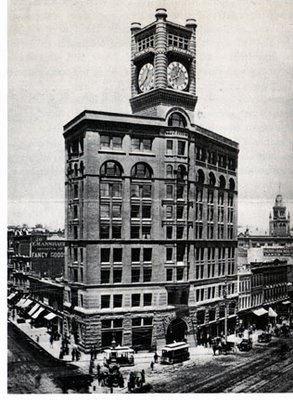
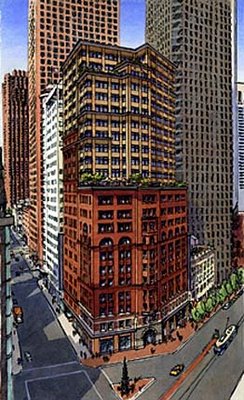 Glancing through ads for pricey real estate I'll never be able to afford in the Sunday New York Times, an ad for the Ritz-Carlton Residences in San Francisco caught my eye. . . . it was 1887 when Burnham & Root were hired by Michael de Young to design a new headquarters for the Chronicle. . . . read the full story and see the pictures here.
Glancing through ads for pricey real estate I'll never be able to afford in the Sunday New York Times, an ad for the Ritz-Carlton Residences in San Francisco caught my eye. . . . it was 1887 when Burnham & Root were hired by Michael de Young to design a new headquarters for the Chronicle. . . . read the full story and see the pictures here.Monday, June 05, 2006
A New James Turrell Skyspace comes to a very different Maxwell Street
The University of Illinois at Chicago refabricates the neighborhood formerly known as Maxwell Street as a new and very different urban reality. Read all about it and see all the photographs here.

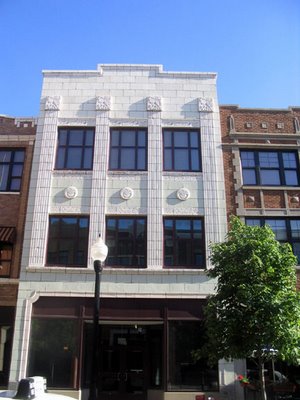




Friday, June 02, 2006
TIF's - Robin Hoods in reverse?
I've written before about how Tax Increment Financing districts (TIF's) have evolved from a strategic tool to redevelop distressed areas of the city to an out-of-control collection of 131 seperate TIF's that accumulate hundreds of millions of dollars in tax revenue every year, siphoned away from general revenues. Now comes this week's Crain's Chicago Business and an article by Greg Hinz that suggests the City of Chicago may be hell-bent on extending the Central Loop Tax Increment Financing district for another 23 years.
Whatever its past problems, no one can claim that the Central Loop District, which is adjacent to Millennium Park, and includes a reinvigorated State Street and a phalanx of new upscale office and condo towers, has any remaining claim to being considered economically challenged, but by now the city has become a TIF junkie, addicted to having those gigantic slush funds to be able to dispense multi-million dollar favors to developers and contractors who will build their projects anyway but have now come to expect large-scale TIF contributions as a gimme. The corruption of TIF's is like the corruption of copyrights - something originally intended for a limited time and defined purpose that high-powered lobbyists have hijacked into a perpetual entitlement.
The irony is that also this week, the city announced that the Chicago Public Schools were raising taxes the maximum amount allowed by law - $55,000,000 - to help plug a massive deficit in next year's budget. By comparison, the Central Loop TIF alone generates nearly $90,000,000 a year. If extended for another 23 year term, that would mean over $2 billion dollars diverted from debt service and basic city services.
Connected developers and contractors get the feast, while the bungalow owners get stuck with the check. Public purposes such as schools, pensions and the CTA face seemingly unending financial crisis even as hundreds of millions of dollars of TIF funds accumulate unspent. This is not sound fiscal management; this is your government on crack. It's as if Grover Norquist, the corporate front ideologue who's made it his mission to destroy the power of government by "starving the beast", has been given the keys to the city.
The outlook will remain ominious unless and until we come to that day when the first big TIF is allowed to expire.
Whatever its past problems, no one can claim that the Central Loop District, which is adjacent to Millennium Park, and includes a reinvigorated State Street and a phalanx of new upscale office and condo towers, has any remaining claim to being considered economically challenged, but by now the city has become a TIF junkie, addicted to having those gigantic slush funds to be able to dispense multi-million dollar favors to developers and contractors who will build their projects anyway but have now come to expect large-scale TIF contributions as a gimme. The corruption of TIF's is like the corruption of copyrights - something originally intended for a limited time and defined purpose that high-powered lobbyists have hijacked into a perpetual entitlement.
The irony is that also this week, the city announced that the Chicago Public Schools were raising taxes the maximum amount allowed by law - $55,000,000 - to help plug a massive deficit in next year's budget. By comparison, the Central Loop TIF alone generates nearly $90,000,000 a year. If extended for another 23 year term, that would mean over $2 billion dollars diverted from debt service and basic city services.
Connected developers and contractors get the feast, while the bungalow owners get stuck with the check. Public purposes such as schools, pensions and the CTA face seemingly unending financial crisis even as hundreds of millions of dollars of TIF funds accumulate unspent. This is not sound fiscal management; this is your government on crack. It's as if Grover Norquist, the corporate front ideologue who's made it his mission to destroy the power of government by "starving the beast", has been given the keys to the city.
The outlook will remain ominious unless and until we come to that day when the first big TIF is allowed to expire.
Thursday, June 01, 2006
AMA - Duck!


 In late April, a pair of ducks took up residence in the fountain of Chicago's AMA Building, the only structure in the city to be designed by the great Japanese architect Kenzo Tange. Despite the common conception otherwise, ducks do not mate for life, but only for the reason, but this couple has seemed inseperable.
In late April, a pair of ducks took up residence in the fountain of Chicago's AMA Building, the only structure in the city to be designed by the great Japanese architect Kenzo Tange. Despite the common conception otherwise, ducks do not mate for life, but only for the reason, but this couple has seemed inseperable.How well ducks can survive in the big, cruel city is a matter of continuing anxiety, especially when, oblivious to heavy traffic all around them, the AMA pair were seen casually crossing a nearby intersection. When they disappeared for a while, one could easily have expected the worst, but this week - assuming they're the same ducks -they were again seen swimming in the fountain, a marvelous, pastoral island of calm amidst the urban frenzy. We're glad to have you, Mr. and Mrs. Duck, but please, be careful out there.
Subscribe to:
Posts (Atom)
